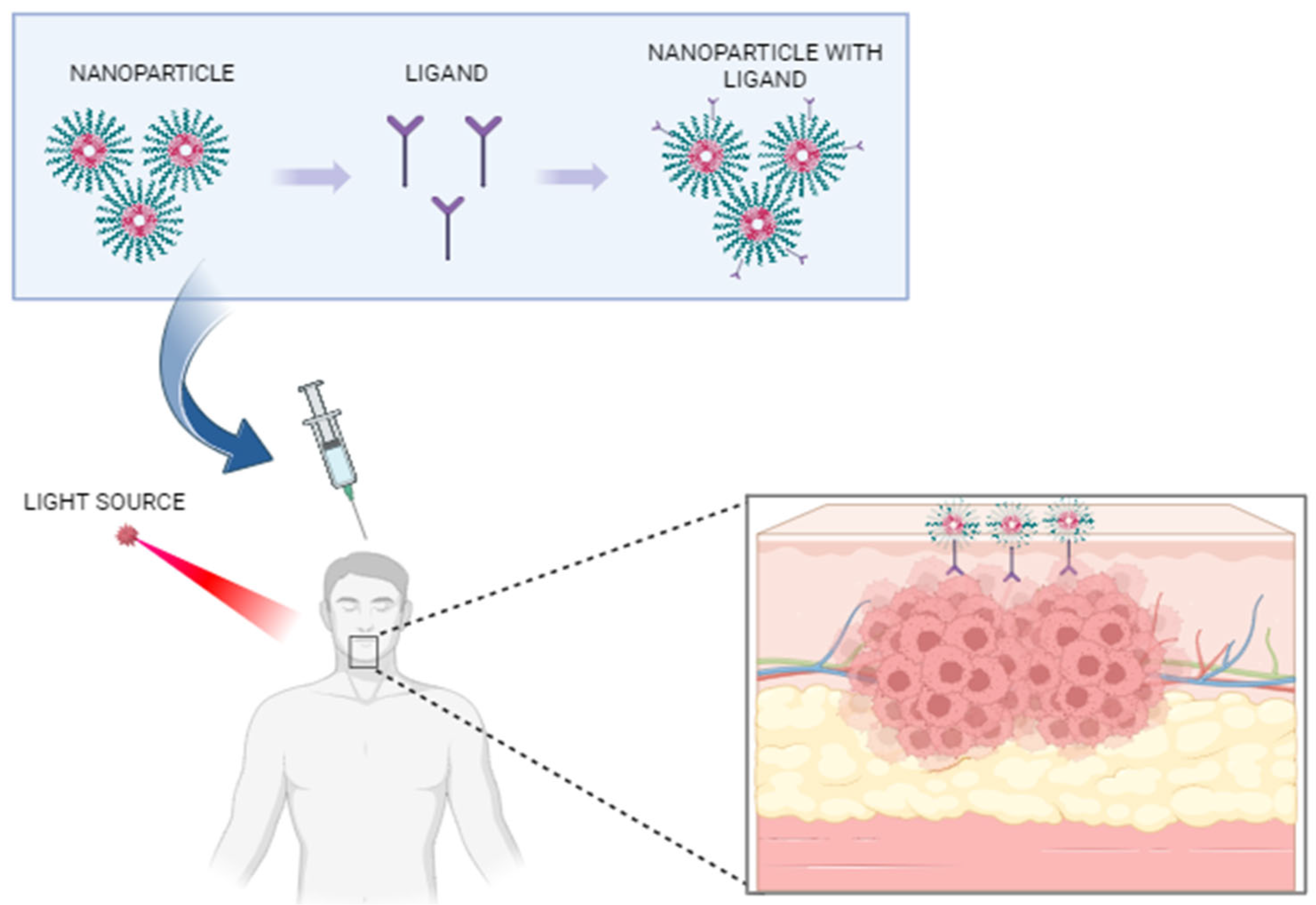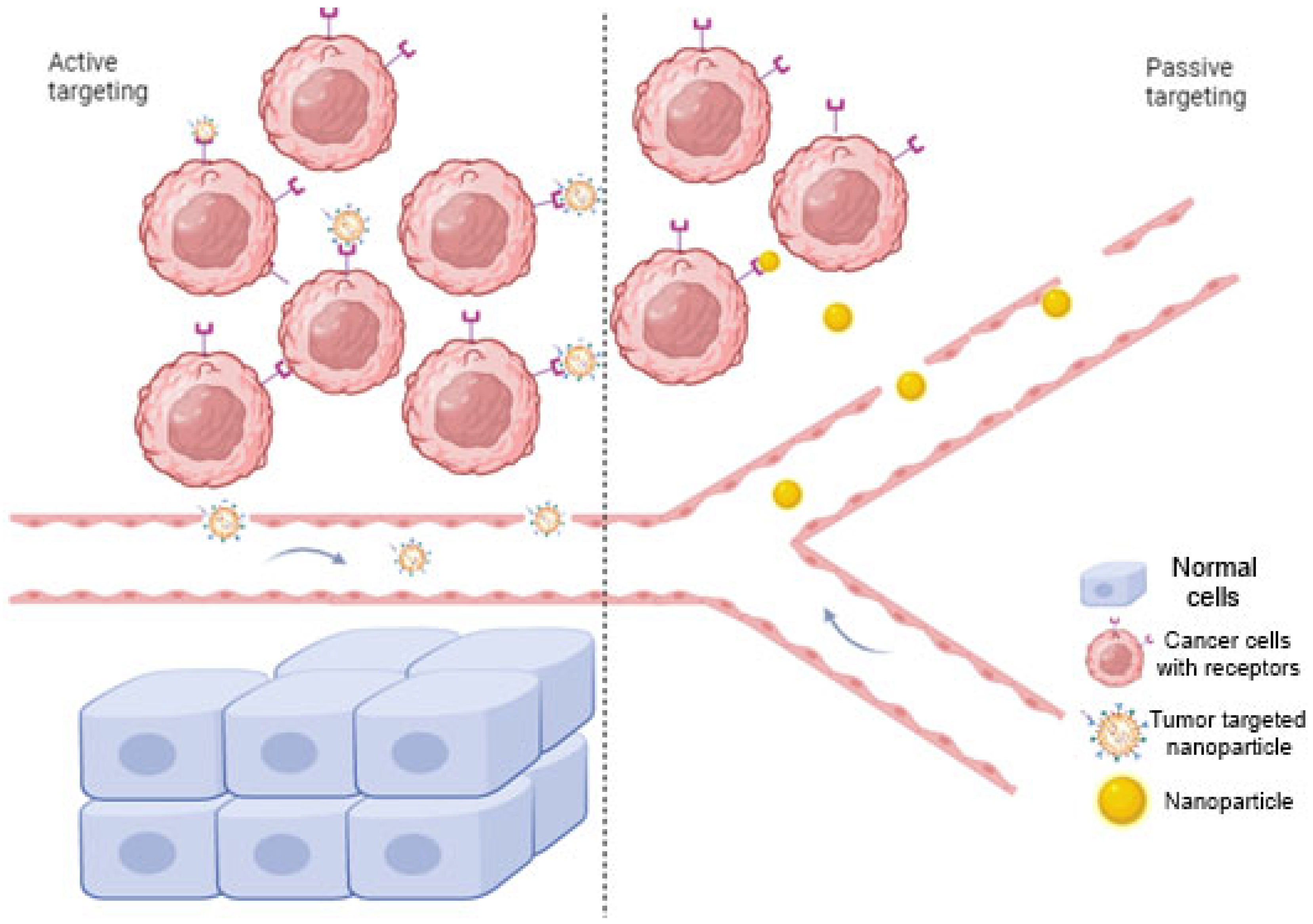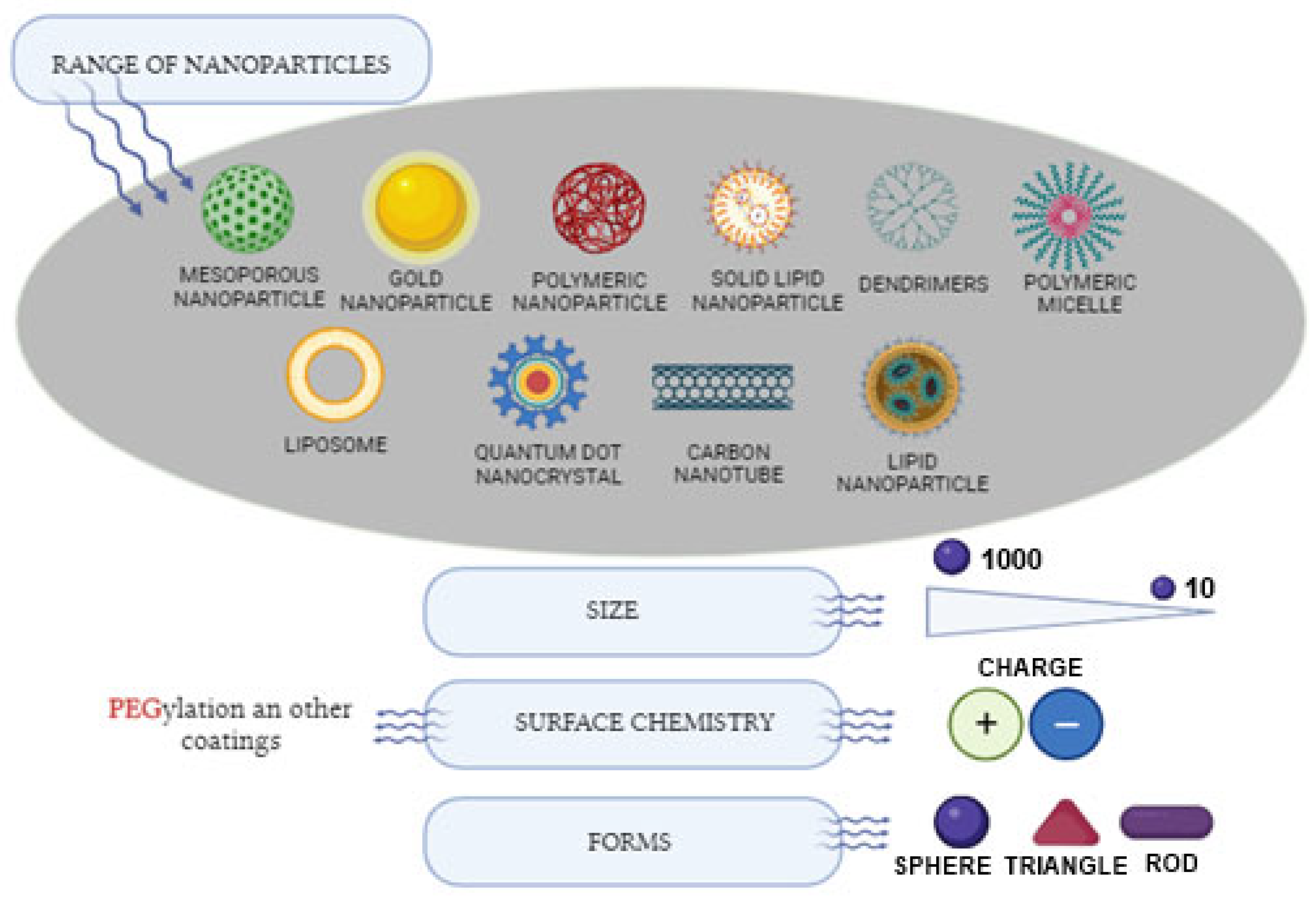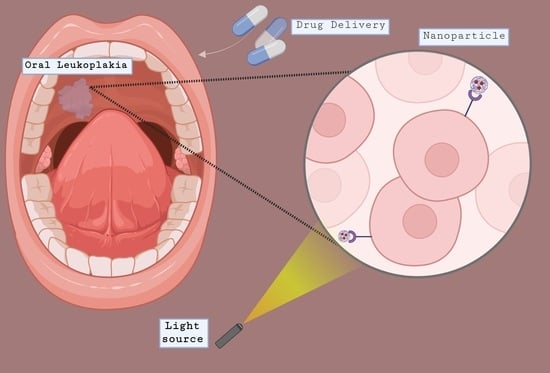The Potential of Nano-Based Photodynamic Treatment as a Therapy against Oral Leukoplakia: A Narrative Review
Abstract
:1. Introduction
- Photosensitizer Administration: A photosensitizing drug is either applied topically to the skin or administered intravenously, depending on the condition being treated. This drug is designed to accumulate in the target cells or tissue.
- Waiting Period: After the photosensitizer is administered, a waiting period is required. This allows time for the drug to be absorbed by the target cells while clearing from the surrounding healthy tissue.
- Light Activation: A specific wavelength of light, often delivered through a laser or non-thermal light source, is directed at the area of interest. This light activates the photosensitizer that accumulates in the target cells.
- Photochemical Reaction: When the photosensitizer is exposed to activating light, it reacts with oxygen, producing a form of oxygen called singlet oxygen. This highly reactive oxygen species damages and destroys the target cells, leading to their death.
- Selective Treatment: PDT is designed to be selective, targeting primarily the cells that have absorbed the photosensitizer, sparing surrounding healthy tissue [6].
2. Oral Leukoplakia
- Speckled—characterized by a mixed white and red appearance (also referred to as erythroleukoplakia) with white attributes predominating [4].
- Nodular—featuring small polypoid outgrowths presenting as rounded red or white protuberances [4].
- Verrucous or exophytic—displaying a surface appearance that is either wrinkled or corrugated [4].
2.1. Diagnosis of Oral Leukoplakia
2.2. Prognosis of Oral Leukoplakia
3. Principles of Nanotechnology
3.1. Nanoparticles
3.2. Particle’s Shape
3.3. Range of Nanoparticles
- Organic NMs encompassing liposomes, polymers, micelles;
- Inorganic NMs include substances like metal nanoparticles and metal oxides, carbon-based materials and mesoporous silica nanoparticles [29].
3.3.1. Inorganic Nanoparticles
Metal Nanoparticle and Metal Oxides
Carbon-Based Materials
Mesoporous Silica-Based Nanomaterials
3.3.2. Organic Nanoparticles
Liposomes
Polymeric Nanoparticles
Micelles
3.3.3. Dendrimers
3.3.4. Nanogels
3.3.5. Quantum Dots
4. The Impact and Future Perspectives of Nanotechnology on Oral Leukoplakia
5. Conclusions
Author Contributions
Funding
Institutional Review Board Statement
Informed Consent Statement
Conflicts of Interest
Abbreviations
| Oral leukoplakia | OL |
| Photodynamic therapy | PDT |
| Photosensitizers | PSc |
| Oral squamous cell carcinoma | OSCC |
| Reactive oxygen species | ROS |
| Proliferative verrucous leukoplakia | PVL |
| Pharmacokinetics-pharmacodynamics | PK/PD |
| Reticuloendothelial system | RES |
| Enhanced permeability and retention | EPR |
| Polyethylene glycol | PEG |
| Nanomaterials | NMs |
| Iron-oxide nanoparticles | IONPs |
| Magnetic resonance imaging | MRI |
| Magnetic particle imaging | MPI |
| Ovalbumin | OVA |
| Carbon nanotubes | CNTs |
| Multi-walled carbon nanotubes | MWCNTs |
| Mesoporous silica based nanomaterials | MSNs |
| Polymeric nanoparticles | PNPs |
| PEGylated liposomal doxirubicin | PLD |
References
- Parlatescu, I.; Gheorghe, C.; Coculescu, E.; Tovaru, S. Oral leukoplakia—An update. Maedica 2014, 9, 88–93. [Google Scholar] [PubMed]
- de-Abreu, M.; dos-Reis, T.; de Barros Gallo, C.; de-Camargo, A.R.; Grando, L.J.; Caldas, R.A.; Rabelo, G.D. Oral leukoplakia evaluation through clinical photography: Classification, interactive segmentation, and automated binarization before going on Artificial Intelligence algorithms. J. Oral. Diagn. 2023, 8, 1–7. [Google Scholar] [CrossRef]
- Lafuente Ibanez de Mendoza, I.; Lorenzo Pouso, A.I.; Aguirre Urizar, J.M.; Barba Montero, C.; Blanco Carrion, A.; Gandara Vila, P.; Perez Sayans, M. Malignant development of proliferative verrucous/multifocal leukoplakia: A critical systematic review, meta-analysis and proposal of diagnostic criteria. J. Oral. Pathol. Med. 2022, 51, 30–38. [Google Scholar] [CrossRef] [PubMed]
- Warnakulasuriya, S. Clinical features and presentation of oral potentially malignant disorders. Oral. Surg. Oral. Med. Oral. Pathol. Oral. Radiol. 2018, 125, 582–590. [Google Scholar] [CrossRef] [PubMed]
- Li, Y.; Wang, B.; Zheng, S.; He, Y. Photodynamic therapy in the treatment of oral leukoplakia: A systematic review. Photodiagn. Photodyn. Ther. 2019, 25, 17–22. [Google Scholar] [CrossRef]
- Niculescu, A.-G.; Grumezescu, A.M. Photodynamic therapy—An up-to-date review. Appl. Sci. 2021, 11, 3626. [Google Scholar] [CrossRef]
- Fahmy, S.A.; Azzazy, H.M.E.; Schaefer, J. Liposome Photosensitizer Formulations for Effective Cancer Photodynamic Therapy. Pharmaceutics 2021, 13, 1345. [Google Scholar] [CrossRef]
- Debele, T.A.; Peng, S.; Tsai, H.C. Drug Carrier for Photodynamic Cancer Therapy. Int. J. Mol. Sci. 2015, 16, 22094–22136. [Google Scholar] [CrossRef]
- Konopka, K.; Goslinski, T. Photodynamic therapy in dentistry. J. Dent. Res. 2007, 86, 694–707. [Google Scholar] [CrossRef]
- Chen, J.; Fan, T.; Xie, Z.; Zeng, Q.; Xue, P.; Zheng, T.; Chen, Y.; Luo, X.; Zhang, H. Advances in nanomaterials for photodynamic therapy applications: Status and challenges. Biomaterials 2020, 237, 119827. [Google Scholar] [CrossRef]
- Cui, S.; Liu, H.; Cui, G. Nanoparticles as drug delivery systems in the treatment of oral squamous cell carcinoma: Current status and recent progression. Front. Pharmacol. 2023, 14, 1420. [Google Scholar] [CrossRef] [PubMed]
- Krajczewski, J.; Rucinska, K.; Townley, H.E.; Kudelski, A. Role of various nanoparticles in photodynamic therapy and detection methods of singlet oxygen. Photodiagn. Photodyn. Ther. 2019, 26, 162–178. [Google Scholar] [CrossRef] [PubMed]
- Habibi, N.; Bissonnette, C.; Pei, P.; Wang, D.; Chang, A.; Raymond, J.E.; Lahann, J.; Mallery, S.R. Mucopenetrating Janus Nanoparticles For Field-Coverage Oral Cancer Chemoprevention. Pharm. Res. 2023, 40, 749–764. [Google Scholar] [CrossRef] [PubMed]
- Staggers, N.; McCasky, T.; Brazelton, N.; Kennedy, R. Nanotechnology: The coming revolution and its implications for consumers, clinicians, and informatics. Nurs. Outlook 2008, 56, 268–274. [Google Scholar] [CrossRef]
- Sabea, D.W.; Al-Mahmood, S.; Salih, H.M. A novel approach in diagnosis and treatment of oral cancer. Int. J. Surg. 2023, 7, 20–28. [Google Scholar] [CrossRef]
- Carrard, V.C.; van der Waal, I. A clinical diagnosis of oral leukoplakia; A guide for dentists. Med. Oral. Patol. Oral. Cir. Bucal 2018, 23, e59–e64. [Google Scholar] [CrossRef] [PubMed]
- Monteiro, L.; Barbieri, C.; Warnakulasuriya, S.; Martins, M.; Salazar, F.; Pacheco, J.J.; Vescovi, P.; Meleti, M. Type of surgical treatment and recurrence of oral leukoplakia: A retrospective clinical study. Med. Oral. Patol. Oral. Cir. Bucal 2017, 22, e520–e526. [Google Scholar] [CrossRef]
- Neville, B.W.; Day, T.A. Oral cancer and precancerous lesions. CA Cancer J. Clin. 2002, 52, 195–215. [Google Scholar] [CrossRef]
- Longshore, S.J.; Camisa, C. Detection and management of premalignant oral leukoplakia. Dermatol. Ther. 2002, 15, 229–235. [Google Scholar] [CrossRef]
- Reibel, J. Prognosis of oral pre-malignant lesions: Significance of clinical, histopathological, and molecular biological characteristics. Crit. Rev. Oral. Biol. Med. 2003, 14, 47–62. [Google Scholar] [CrossRef]
- Gonzalez-Moles, M.A.; Warnakulasuriya, S.; Ramos-Garcia, P. Prognosis Parameters of Oral Carcinomas Developed in Proliferative Verrucous Leukoplakia: A Systematic Review and Meta-Analysis. Cancers 2021, 13, 4843. [Google Scholar] [CrossRef] [PubMed]
- Kumar, A.; Cascarini, L.; McCaul, J.A.; Kerawala, C.J.; Coombes, D.; Godden, D.; Brennan, P.A. How should we manage oral leukoplakia? Br. J. Oral. Maxillofac. Surg. 2013, 51, 377–383. [Google Scholar] [CrossRef] [PubMed]
- Umapathy, V.R.; Natarajan, P.M.; Swamikannu, B. Review of the Role of Nanotechnology in Overcoming the Challenges Faced in Oral Cancer Diagnosis and Treatment. Molecules 2023, 28, 5395. [Google Scholar] [CrossRef]
- Kemp, J.A.; Kwon, Y.J. Cancer nanotechnology: Current status and perspectives. Nano Converg. 2021, 8, 34. [Google Scholar] [CrossRef] [PubMed]
- Yetisgin, A.A.; Cetinel, S.; Zuvin, M.; Kosar, A.; Kutlu, O. Therapeutic Nanoparticles and Their Targeted Delivery Applications. Molecules 2020, 25, 2193. [Google Scholar] [CrossRef] [PubMed]
- Prabhu, R.H.; Patravale, V.B.; Joshi, M.D. Polymeric nanoparticles for targeted treatment in oncology: Current insights. Int. J. Nanomed. 2015, 1001–1018. [Google Scholar] [CrossRef]
- Yao, C.G.; Martins, P.N. Nanotechnology Applications in Transplantation Medicine. Transplantation 2020, 104, 682–693. [Google Scholar] [CrossRef]
- Liu, R.; Luo, C.; Pang, Z.; Zhang, J.; Ruan, S.; Wu, M.; Wang, L.; Sun, T.; Li, N.; Han, L. Advances of nanoparticles as drug delivery systems for disease diagnosis and treatment. Chin. Chem. Lett. 2023, 34, 107518. [Google Scholar] [CrossRef]
- Navya, P.; Kaphle, A.; Srinivas, S.; Bhargava, S.K.; Rotello, V.M.; Daima, H.K. Current trends and challenges in cancer management and therapy using designer nanomaterials. Nano Converg. 2019, 6, 1–30. [Google Scholar] [CrossRef]
- Raj, S.; Khurana, S.; Choudhari, R.; Kesari, K.K.; Kamal, M.A.; Garg, N.; Ruokolainen, J.; Das, B.C.; Kumar, D. Specific targeting cancer cells with nanoparticles and drug delivery in cancer therapy. Semin. Cancer Biol. 2021, 69, 166–177. [Google Scholar] [CrossRef]
- Rawat, M.; Jain, N. Nanoparticles: Opportunities, biopharmaceuticals aspects, and applications. In Multifunctional Nanocarriers; Elsevier: Amsterdam, The Netherlands, 2022; pp. 175–201. [Google Scholar]
- Choo, P.; Liu, T.; Odom, T.W. Nanoparticle Shape Determines Dynamics of Targeting Nanoconstructs on Cell Membranes. J. Am. Chem. Soc. 2021, 143, 4550–4555. [Google Scholar] [CrossRef] [PubMed]
- Liu, Y.; Tan, J.; Thomas, A.; Ou-Yang, D.; Muzykantov, V.R. The shape of things to come: Importance of design in nanotechnology for drug delivery. Ther. Deliv. 2012, 3, 181–194. [Google Scholar] [CrossRef] [PubMed]
- Chen, L.; Huang, J.; Li, X.; Huang, M.; Zeng, S.; Zheng, J.; Peng, S.; Li, S. Progress of Nanomaterials in Photodynamic Therapy Against Tumor. Front. Bioeng. Biotechnol. 2022, 10, 920162. [Google Scholar] [CrossRef]
- Cai, W.; Gao, T.; Hong, H.; Sun, J. Applications of gold nanoparticles in cancer nanotechnology. Nanotechnol. Sci. Appl. 2008, 17–32. [Google Scholar] [CrossRef] [PubMed]
- Silva, A.K.A.; Espinosa, A.; Kolosnjaj-Tabi, J.; Wilhelm, C.; Gazeau, F. Medical applications of iron oxide nanoparticles. Iron Oxides Nat. Appl. 2016, 425–472. [Google Scholar] [CrossRef]
- Kwon, S.; Singh, R.K.; Perez, R.A.; Abou Neel, E.A.; Kim, H.W.; Chrzanowski, W. Silica-based mesoporous nanoparticles for controlled drug delivery. J. Tissue Eng. 2013, 4, 2041731413503357. [Google Scholar] [CrossRef] [PubMed]
- Couleaud, P.; Morosini, V.; Frochot, C.; Richeter, S.; Raehm, L.; Durand, J.O. Silica-based nanoparticles for photodynamic therapy applications. Nanoscale 2010, 2, 1083–1095. [Google Scholar] [CrossRef]
- Hong, S.H.; Choi, Y. Mesoporous silica-based nanoplatforms for the delivery of photodynamic therapy agents. J. Pharm. Investig. 2018, 48, 3–17. [Google Scholar] [CrossRef]
- Mekaru, H.; Lu, J.; Tamanoi, F. Development of mesoporous silica-based nanoparticles with controlled release capability for cancer therapy. Adv. Drug Deliv. Rev. 2015, 95, 40–49. [Google Scholar] [CrossRef]
- Wilczewska, A.Z.; Niemirowicz, K.; Markiewicz, K.H.; Car, H. Nanoparticles as drug delivery systems. Pharmacol. Rep. 2012, 64, 1020–1037. [Google Scholar] [CrossRef]
- Saraf, S.; Jain, A.; Tiwari, A.; Verma, A.; Panda, P.K.; Jain, S.K. Advances in liposomal drug delivery to cancer: An overview. J. Drug Deliv. Sci. Technol. 2020, 56, 101549. [Google Scholar] [CrossRef]
- De Leo, V.; Maurelli, A.M.; Giotta, L.; Catucci, L. Liposomes containing nanoparticles: Preparation and applications. Colloids Surf. B Biointerfaces 2022, 218, 112737. [Google Scholar] [CrossRef] [PubMed]
- Srivastava, S.; Gupta, O.P.; Nigam, K.; Suhail, S.; Gupta, S. Nanotechnology in Oral Cancer: Novel Approach Towards Detection and Drug Therapy. Pharm. Chem. J. 2016, 3, 12–16. [Google Scholar]
- Banik, B.L.; Fattahi, P.; Brown, J.L. Polymeric nanoparticles: The future of nanomedicine. Wiley Interdiscip. Rev. Nanomed. Nanobiotechnol 2016, 8, 271–299. [Google Scholar] [CrossRef]
- Afsharzadeh, M.; Hashemi, M.; Mokhtarzadeh, A.; Abnous, K.; Ramezani, M. Recent advances in co-delivery systems based on polymeric nanoparticle for cancer treatment. Artif. Cells Nanomed. Biotechnol. 2018, 46, 1095–1110. [Google Scholar] [CrossRef]
- Miyata, K.; Christie, R.J.; Kataoka, K. Polymeric micelles for nano-scale drug delivery. React. Funct. Polym. 2011, 71, 227–234. [Google Scholar] [CrossRef]
- Barrett, T.; Ravizzini, G.; Choyke, P.L.; Kobayashi, H. Dendrimers in medical nanotechnology. IEEE Eng. Med. Biol. Mag. 2009, 28, 12–22. [Google Scholar] [CrossRef]
- Wang, H.; Gao, L.; Fan, T.; Zhang, C.; Zhang, B.; Al-Hartomy, O.A.; Al-Ghamdi, A.; Wageh, S.; Qiu, M.; Zhang, H. Strategic Design of Intelligent-Responsive Nanogel Carriers for Cancer Therapy. ACS Appl. Mater. Interfaces 2021, 13, 54621–54647. [Google Scholar] [CrossRef]
- Suhail, M.; Rosenholm, J.M.; Minhas, M.U.; Badshah, S.F.; Naeem, A.; Khan, K.U.; Fahad, M. Nanogels as drug-delivery systems: A comprehensive overview. Ther. Deliv. 2019, 10, 697–717. [Google Scholar] [CrossRef]
- Zha, L.; Banik, B.; Alexis, F. Stimulus responsive nanogels for drug delivery. Soft Matter 2011, 7, 5908–5916. [Google Scholar] [CrossRef]
- Devi, S.; Kumar, M.; Tiwari, A.; Tiwari, V.; Kaushik, D.; Verma, R.; Bhatt, S.; Sahoo, B.M.; Bhattacharya, T.; Alshehri, S. Quantum dots: An emerging approach for cancer therapy. Front. Mater. 2022, 8, 798440. [Google Scholar] [CrossRef]
- Khan, M.S.; Sheikh, A.; Abourehab, M.A.; Gupta, N.; Kesharwani, P. Understanding the theranostic potential of quantum dots in cancer management. Mater. Today Commun. 2023, 106424. [Google Scholar] [CrossRef]
- Zhao, M.-X.; Zhu, B.-J. The research and applications of quantum dots as nano-carriers for targeted drug delivery and cancer therapy. Nanoscale Res. Lett. 2016, 11, 1–9. [Google Scholar] [CrossRef]
- Singh, D.K.; Dash, K.C. Quantum dots: A diagnostic and therapeutic boon in oral cancer. Glob. J. Biosci. Biotechnol. 2018, 7, 204–208. [Google Scholar]
- Zheng, W.; Zhou, Q.; Yuan, C. Nanoparticles for Oral Cancer Diagnosis and Therapy. Bioinorg. Chem. Appl. 2021, 2021, 9977131. [Google Scholar] [CrossRef] [PubMed]
- Misra, R.; Acharya, S.; Sahoo, S.K. Cancer nanotechnology: Application of nanotechnology in cancer therapy. Drug Discov. Today 2010, 15, 842–850. [Google Scholar] [CrossRef] [PubMed]
- Izci, M.; Maksoudian, C.; Manshian, B.B.; Soenen, S.J. The Use of Alternative Strategies for Enhanced Nanoparticle Delivery to Solid Tumors. Chem. Rev. 2021, 121, 1746–1803. [Google Scholar] [CrossRef]
- Kaur, A.; Kaur, M.A.; Shahi, M.N. How nanotechnology works in medicine. Int. J. Electron. Comput. Sci. Eng. 2012, 1, 2452–2459. [Google Scholar]
- Li, H.; Zhang, Y.; Xu, M.; Yang, D. Current trends of targeted therapy for oral squamous cell carcinoma. J. Cancer Res. Clin. Oncol. 2022, 148, 2169–2186. [Google Scholar] [CrossRef]
- Zhang, R.; Gao, T.; Wang, D. Photodynamic therapy (PDT) for oral leukoplakia: A systematic review and meta-analysis of single-arm studies examining efficacy and subgroup analyses. BMC Oral. Health 2023, 23, 568. [Google Scholar] [CrossRef]
- Siddiqui, I.A.; Sanna, V. Impact of nanotechnology on the delivery of natural products for cancer prevention and therapy. Mol. Nutr. Food Res. 2016, 60, 1330–1341. [Google Scholar] [CrossRef] [PubMed]
- Farokhzad, O.C.; Langer, R. Impact of nanotechnology on drug delivery. ACS Nano 2009, 3, 16–20. [Google Scholar] [CrossRef] [PubMed]
- Lucchese, A.; Matarese, G.; Manuelli, M.; Ciuffreda, C.; Bassani, L.; Isola, G.; Cordasco, G.; Gherlone, E. Reliability and efficacy of palifermin in prevention and management of oral mucositis in patients with acute lymphoblastic leukemia: A randomized, double-blind controlled clinical trial. Minerva Stomatol. 2016, 65, 43–50. [Google Scholar] [PubMed]
- Poonia, M.; Ramalingam, K.; Goyal, S.; Sidhu, S.K. Nanotechnology in oral cancer: A comprehensive review. J. Oral Maxillofac. Pathol. JOMFP 2017, 21, 407. [Google Scholar]



| Beneficial Properties | ||
|---|---|---|
| Improved internalization into cancer cells | Induction of apoptosis | Bioeffectivenes |
| Improved drug accumulation at target sites | Enhanced anticancer efficacy | Limited adverse effects |
| Reduced systemic toxicity | Traversing the tissue with less reduction of blood volume | Customized allocation |
| Enhanced cytotoxicity of cancer cells | Eliminate dysplastic cells while sparing the healthy ones | |
| Nanomaterials | Advantages | Disadvantages |
|---|---|---|
| Gold nanoparticles | Chemical stability Strong biocompatibility | Au-S bond exhibits limited stability |
| Silver nanoparticle | Safe delivery carriers | |
| Iron oxide | Good compatibility Activation of immune cells | Negative contrast effects |
| Carbon based | Antimicrobial efficacy | Potential to gather in pulmonary tissue |
| Mesoporous silica based | Consistent porosity Minimal toxicity | |
| Liposomes | Biocompatibility Minimal immunogenicity | Reduced stability |
| Micelles | Control liberation of medication | |
| Dendrimers | Water solubility | |
| Nanogels | Biodegradability | |
| Quantum dots | Durability |
| Not suitable for the delivery of proteins and bio-macromolecules |
| Solid lipid nanoparticles show initial burst drug release |
| Difficult to handle at times because of particle-particle aggregation |
| Inorganic NPs like carbon nanotubes have toxic characteristics associated with immune response |
| They possess a non-specific site of action; therefore, it is difficult to differentiate between healthy and tumor cells |
| Unable to penetrate the biological membranes, as a result of the poor solubility of the drugs |
| Inability to penetrate into solid tumors, unable to destroy the cancerous cells |
| They exhibit more systemic cytotoxicity and poor bioavailability |
| Macrophages engulf the drugs in a short period of time, resulting with a short interaction with cancerous cells |
| These agents act directly on rapidly growing tumor cells, also damaging the healthy cells resulting in a treatment delay |
Disclaimer/Publisher’s Note: The statements, opinions and data contained in all publications are solely those of the individual author(s) and contributor(s) and not of MDPI and/or the editor(s). MDPI and/or the editor(s) disclaim responsibility for any injury to people or property resulting from any ideas, methods, instructions or products referred to in the content. |
© 2023 by the authors. Licensee MDPI, Basel, Switzerland. This article is an open access article distributed under the terms and conditions of the Creative Commons Attribution (CC BY) license (https://creativecommons.org/licenses/by/4.0/).
Share and Cite
Angjelova, A.; Jovanova, E.; Polizzi, A.; Santonocito, S.; Lo Giudice, A.; Isola, G. The Potential of Nano-Based Photodynamic Treatment as a Therapy against Oral Leukoplakia: A Narrative Review. J. Clin. Med. 2023, 12, 6819. https://doi.org/10.3390/jcm12216819
Angjelova A, Jovanova E, Polizzi A, Santonocito S, Lo Giudice A, Isola G. The Potential of Nano-Based Photodynamic Treatment as a Therapy against Oral Leukoplakia: A Narrative Review. Journal of Clinical Medicine. 2023; 12(21):6819. https://doi.org/10.3390/jcm12216819
Chicago/Turabian StyleAngjelova, Angela, Elena Jovanova, Alessandro Polizzi, Simona Santonocito, Antonino Lo Giudice, and Gaetano Isola. 2023. "The Potential of Nano-Based Photodynamic Treatment as a Therapy against Oral Leukoplakia: A Narrative Review" Journal of Clinical Medicine 12, no. 21: 6819. https://doi.org/10.3390/jcm12216819









